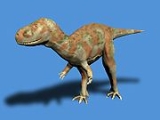
Skorpiovenator
Encyclopedia
Skorpiovenator is a genus
of abelisaurid theropod dinosaur
from the late Cretaceous period of Argentina
.
 The type species
The type species
, Skorpiovenator bustingorryi, is known from a single, nearly complete skeleton missing only most of the forelimbs and parts of the tail. The specimen was recovered from the lower part of the Huincul Formation
in Patagonia
, dating to the late Cenomanian
stage, about 95 million years ago. It would have lived alongside other carnivorous dinosaurs such as the carcharodontosaurid Mapusaurus
and another abelisaurid, Ilokelesia
.
The type specimen was described and named by Canale, Scanferla, Agnolin, and Novas in 2009 (though the paper was released as an advanced publication online in 2008). The name Skorpiovenator bustingorryi is derived from the Greek and Latin for "scorpion hunter," due to the abundant scorpions present at the dig site, and the specific name honors Manuel Bustingorry, who owned the farm where the specimen was found. The describers have defined a new name Brachyrostra for a clade
, to which Skorpiovenator belonged.
Genus
In biology, a genus is a low-level taxonomic rank used in the biological classification of living and fossil organisms, which is an example of definition by genus and differentia...
of abelisaurid theropod dinosaur
Dinosaur
Dinosaurs are a diverse group of animals of the clade and superorder Dinosauria. They were the dominant terrestrial vertebrates for over 160 million years, from the late Triassic period until the end of the Cretaceous , when the Cretaceous–Paleogene extinction event led to the extinction of...
from the late Cretaceous period of Argentina
Argentina
Argentina , officially the Argentine Republic , is the second largest country in South America by land area, after Brazil. It is constituted as a federation of 23 provinces and an autonomous city, Buenos Aires...
.

Type species
In biological nomenclature, a type species is both a concept and a practical system which is used in the classification and nomenclature of animals and plants. The value of a "type species" lies in the fact that it makes clear what is meant by a particular genus name. A type species is the species...
, Skorpiovenator bustingorryi, is known from a single, nearly complete skeleton missing only most of the forelimbs and parts of the tail. The specimen was recovered from the lower part of the Huincul Formation
Huincul Formation
The Huincul Formation is a geologic formation that outcrops in Río Negro and Neuquén provinces of Argentina. It is the second formation in the Río Limay Subgroup, the oldest subgroup within the Neuquén Group...
in Patagonia
Patagonia
Patagonia is a region located in Argentina and Chile, integrating the southernmost section of the Andes mountains to the southwest towards the Pacific ocean and from the east of the cordillera to the valleys it follows south through Colorado River towards Carmen de Patagones in the Atlantic Ocean...
, dating to the late Cenomanian
Cenomanian
The Cenomanian is, in the ICS' geological timescale the oldest or earliest age of the Late Cretaceous epoch or the lowest stage of the Upper Cretaceous series. An age is a unit of geochronology: it is a unit of time; the stage is a unit in the stratigraphic column deposited during the corresponding...
stage, about 95 million years ago. It would have lived alongside other carnivorous dinosaurs such as the carcharodontosaurid Mapusaurus
Mapusaurus
Mapusaurus was a giant carnosaurian dinosaur from the early Late Cretaceous of what is now Argentina. It was similar in size to its close relative Giganotosaurus, with the largest known individuals estimated as over in length and weighing approximately...
and another abelisaurid, Ilokelesia
Ilokelesia
Ilokelesia is a primitive abelisaur found in 1991, preserved in the layers of the earliest Late Cretaceous of the Río Limay Formation, Neuquén Group, located near Plaza Huincul, Neuquén Province, Argentina. The specimen, consisting of very fragmentary elements of the skull, the axial and the...
.
The type specimen was described and named by Canale, Scanferla, Agnolin, and Novas in 2009 (though the paper was released as an advanced publication online in 2008). The name Skorpiovenator bustingorryi is derived from the Greek and Latin for "scorpion hunter," due to the abundant scorpions present at the dig site, and the specific name honors Manuel Bustingorry, who owned the farm where the specimen was found. The describers have defined a new name Brachyrostra for a clade
Clade
A clade is a group consisting of a species and all its descendants. In the terms of biological systematics, a clade is a single "branch" on the "tree of life". The idea that such a "natural group" of organisms should be grouped together and given a taxonomic name is central to biological...
, to which Skorpiovenator belonged.

